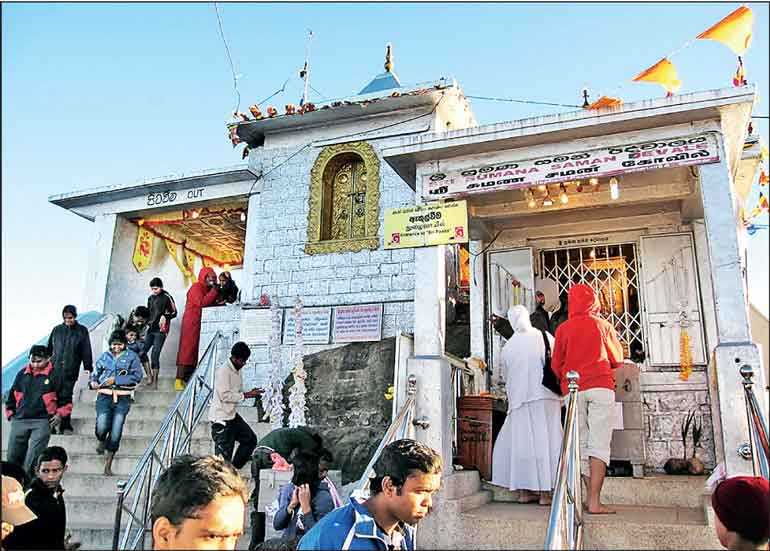Monday Oct 27, 2025
Monday Oct 27, 2025
Saturday, 14 December 2019 00:10 - - {{hitsCtrl.values.hits}}
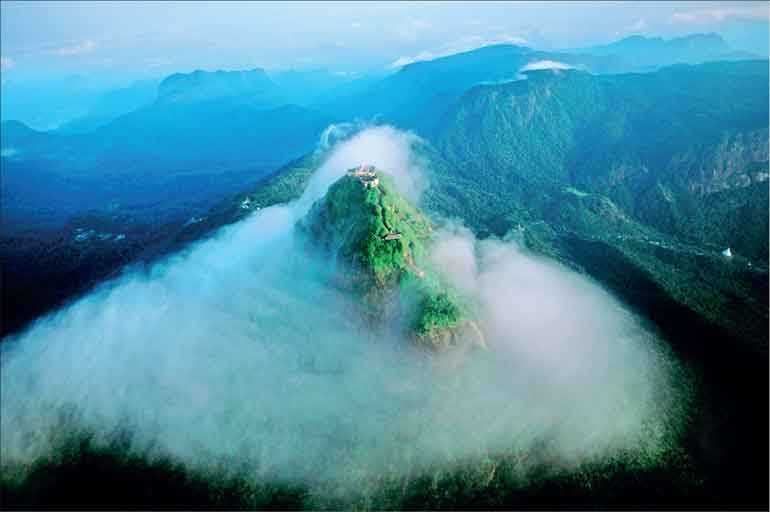
By D.C. Ranatunga
The annual Sri Pada pilgrim season has begun. Following tradition, Unduwap full moon Poya Day last Wednesday marked the beginning of the season which goes on till May next year. The climax of the season is in March when devotees flock to climb the 2,243 metres to worship the footprint of the Buddha. Large crowds are seen on the peak on full moon Poya day in March.
For centuries, the fifth highest peak in Sri Lanka popularly known as Adam’s Peak, has been the most venerated mountain in the world. “A mountain of great historical interest, which has allured to its heights millions of the human race, the assent of which should be accomplished by all travellers who are possessed of the necessary physical energy and physique for the task,” writes Henry W. Cave in ‘Ceylon along the Rail Track’(1903).
Obviously in the early days it had been a tough climb through the forest with no proper steps or a proper route. It has changed over the years and the Government has provided facilities to make it a comfortable climb.
It is significant that the faithfuls of different religions believe the footprint has been left by a notable personality of their religion. ‘The Encyclopaedia of Sri Lanka’ (C.A. Gunawardena – 2003) refers to the different theories.
The Buddhists refer to the Peak as ‘Sri Pada’ believing that the Buddha visited on the invitation of God Saman and left the footprint on the slab of a rock that is being worshipped today. The Muslims believe that Adam – the first man and prophet – landed on one foot on the peak when he was banished from Paradise. The Hindus believe that it is the footprint of God Shiva. Some Christians believe that it was left by Saint Thomas, one of the 12 apostles of Jesus, who is said to have brought the Christian message to the subcontinent.
References to the peak have been made by numerous travellers to the country over centuries. The first account of a visit to the peak is recorded to be that of Ibn Batuta, Moroccan scholar and explorer who had visited Sri Lanka in 1344.
He wrote: “The blessed Footprint, the Foot of our father Adam, is on a lofty black rock in a wide plateau. The blessed Foot sank into the rock far enough to leave its impression hollowed out. It is eleven spans long.” (‘Travels in Asia and Africa’).
“A natural cathedral so stupendous and exquisite that none can stand upon it without worship in is soul,” is how Harry Williams, a tea planter, refers to Sri Pada in his book ‘Ceylon: Pearl of the East’.
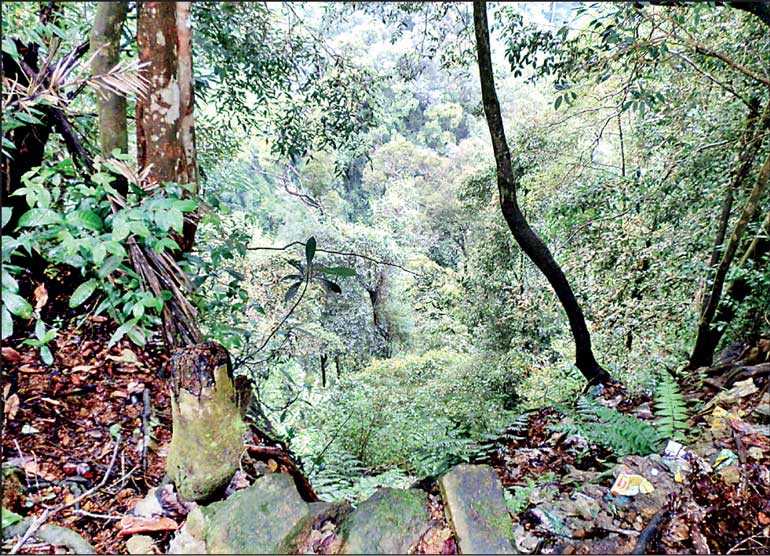
“The peak itself is a last gesture of defiance from a land mass between the Himalayas and the South Pole, a kind of Ultima Thule… And when one is standing on its last pinnacle, with the wilderness of the peak, a tumbled, primeval forest at one’s feet, the belief that the spirits of the men who have worshipped there throughout all the ages hover in the clouds, the rising mists, among the trees, caves and dark crevices with which its towering slopes are honeycombed, is not difficult to believe. In the dark, before the first trembling of the light, it is difficult not to believe.”
Emerson Tenant, the 19th century British civil servant who served many years in the country, wrote in ‘Ceylon,’ one of his many books: “The panorama is also perhaps the grandest in the world, as no other mountain, although surpassing in altitude, presents the same unobstructed view over land and sea.”
Marco Polo, the Venetian merchant-explorer who visited Sri Lanka in the 13th century while writing that it is the footprint of Adam according to Muslims, notes that according to Buddhists it is the footprint of Gautama Buddha.
H.W. Cave discusses the different paths to approach the peak in his book. Referring to the sacred character of the mountain, he writes: “There is no object more familiar to the inhabitants of Ceylon, or one that makes a deeper impression upon the multitudes who visit her shores than the lofty cone which bears the name of our first parent; and it may be said without fear of contradiction that among all mountains in the world invested by tradition with superstitious veneration none has stirred the emotions of so many of our fellow-subjects as Adam’s Peak. The origin of its sacred character, involved ta once as it is in the legendary history of several ancient religions, has been the subject of considerable research and greater conjecture.
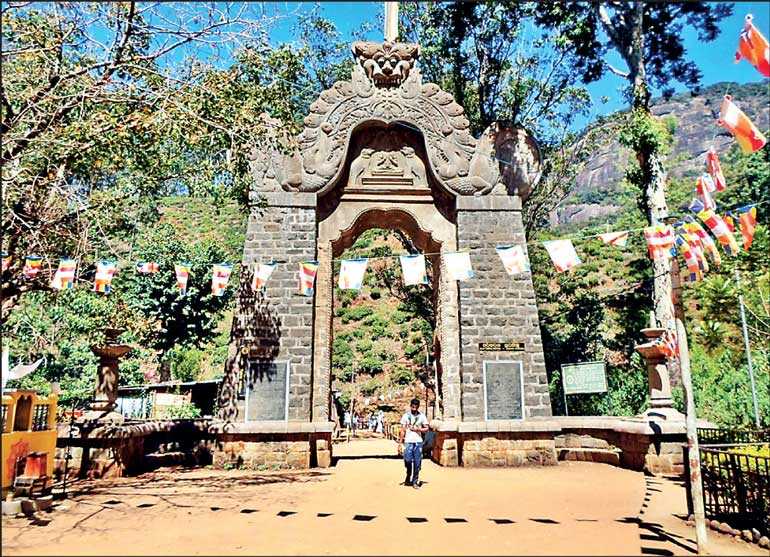
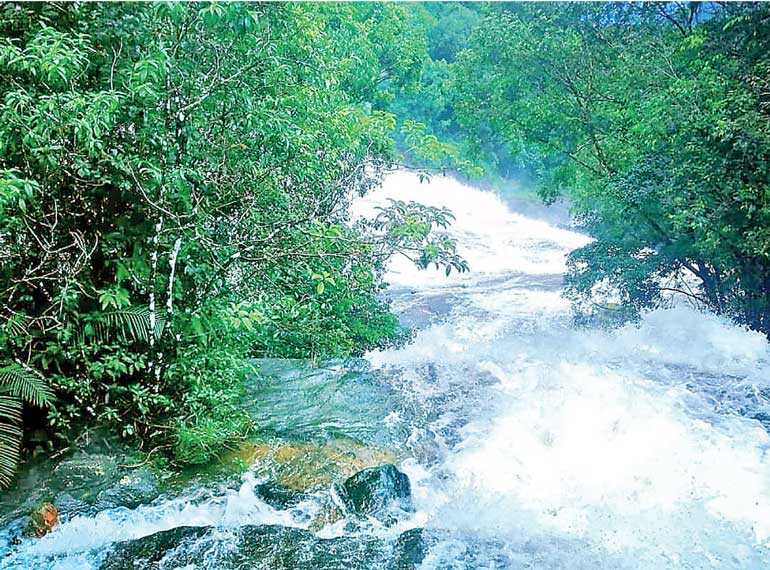
“There is no doubt that the legends take their rise in the mark of the summit resembling the impress of a gigantic human foot. This the Buddhists devoutly worship as the sacred footprint of Gautama, while the Hindoos (Hindus) equally claim it as that of Siva, and the Mahommedans, borrowing their history from the Jews, as that of Adam. Thus do the adherents of three great religions, to the number of 800,000,000 of our fellow creatures, vie with one another in veneration of the lonely peak. As in pilgrim bands they ascend the mighty cone of their hearts are moved and they regard their rugged paths as steps into heaven.
“From all parts of Asia thousands annually flock up the steep and rocky track, enduring privation and hardship for the good of their souls. Some of the very old people of both sexes are borne aloft upon the shoulders of their stalwart sons, others struggle upwards unaided, until, fainting by the way they are considerately carried with all haste in their swooning condition to the summit and forced into attitude of worship at the shrine to secure the full benefits of their pilgrimage before death would supervene; others never reach the top at all, but perish from cold and fatigue; and there have been many instances of pilgrims losing their lives by being blown over precipices or falling from giddiness induced by a thoughtless retrospect when surmounting especially dangerous cliffs.” How things have changed and it is a perfectly safe and pleasant journey today.
